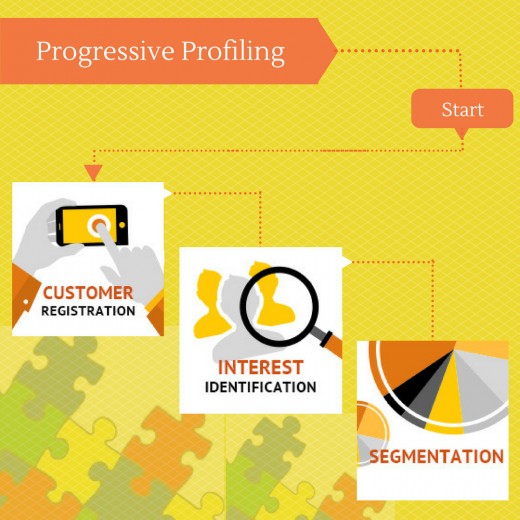Progressive Profiling : What it is and how to do it right way?

Have you ever been in the place when your customer’s eyes started glazing over due to the over detailed talks? And that is the moment you realize, they are no longer interested. You are no longer in a two-way conversation with them; they might be thinking about dinner or what they want to do once they get back to their office. And this is how you know you lost them. Soon, they start turning into walking dead and leave right out the door!
Well, the same thing happens in online business as well. The increasing use of long registration process to understand your customers can make your prospective customers walk right out of the funnel. Below are the stats to prove you the same :
-
Conversion falls by 5% with every field added to the signup form beyond 5
-
The increase of text fields from 1 to 4 results in up to 10% drop in conversions.
-
Making the number of select boxes from 1 to 5 will plummet conversions to 13% from 17% (Source)
..And the list goes on!
Quite a paralyzing realization, isn’t it? Wait, there's more to it!
-
⅓ people provide fake email address and name at least some of the time due to the complicated registration process.
-
60% of consumers intentionally provide false data while submitting personal information online. (Source)
And do I need to say, bad leads are also the waste of time? They are going to waste your time and they are going to waste your customer’s time while you could have made the profit.
So should one completely avoid registration process? Of course not! Businesses need information to nurture customers. But the problem is you are collecting this information via these happy-to-avoid long registration forms plus don’t forget that headache you’re putting for customers. So what do you do? Well, how about taking a bypass route? I know this will make the journey longer but it will ensure smoothness and safety. Wondering how?
Progressive Profiling is the answer!
Now compare this customer onboarding process with dating. How would you feel if you are proposed for the marriage on your very first date? Ducking yourself to the washroom and fleeing from the place sounds a great option, isn’t it?
Now let’s look at it this way, what if your date asks you, “So do you have any medical issues?? Yeah??, “??” would be your expression, right? The question is irrelevant to be asked on the first date.
I am sure this quick exercise must have made you realize where your conversion funnel is missing the point. The commitment proposal is dropped way too soon and the information asked is not at all relevant at that time.
Progressive profiling handles both of the issues conscientiously. How?
You want information? Get it in chunks..
Progressive profiling syncs your marketing messages with customer steps and guides him through your desired end of the conversion funnel. The basic idea of progressive profiling is to ask the prospects a series of questions about them over the series of steps.
For eg, the first time they land on your website, you can ask for their name and email address. And by the time, as you move forward, you can request your returning customers to fill more details (update profile). Every new encounter with your customer is a new opportunity to understand him a bit more. Starting with the basic information, you can make your way through more specific details like hobbies, dislikes, etc.
Thus progressive profiling lets your client come to you thereby eliminating the pushy sales aspect. Now before exploring the right way to do progressive profiling, let’s go through the benefits of progressive profiling over long registration form, for both customers as well as you.
Benefits of progressive profiling for your customers:
1. Better On Site experience:
With progressive profiling, you are not asking all the questions at once, nor your questions are irrelevant. You are allowing them to dip their toe in the water and reel them slowly thus ensuring a smooth user experience. Progressive profiling makes sure you don’t seem intrusive or desperate to your customers.
2. Builds trust:
Did you know asking for the phone number can cause 5% dip in conversions? Moreover, it also makes your customers feel pushed upon for sales. But with progressive profiling, you are not asking everything at once thereby gives them time to build trust in you.
3. Personalized recommendations:
Now that customers are willingly providing you their personal details, you can make better marketing strategies so as to please them with services that interest them. And personalization is the key to make your customers stick around and convert them into loyal customers.
Benefits of progressive profiling for businesses :
1. Higher Conversion rates:
Remember, we discussed above how friction can make your customers bounce back? Well, making your forms shorter makes sure that customers face minimum trouble, cart abandonment rates will be low and at the same time, you don’t miss on any important detail about them. Here’s the proof:
As tested by Hubspot on around 40,000 forms, reducing form fields from 4 to 3, lead to 50% increase in conversions!
2. Better quality leads:
Now since you are not forcing your customers to answer the countless questions, you can be sure that they won’t end up dirtying your database with false details. Your leads will be more accurate thereby sales cycle getting shorter, faster and higher chances of closing the deal.
3. More detailed buyer persona:
Just like dating where you understand your partner gradually, in progressive profiling too, you slowly collect details about your customer that build up a strong buyer persona. This buyer persona helps in making this journey of customer conversion more intimate and with mutual trust.
In short, implementing progressive profiling is a win win situation for both you and your customers. But to make it reach at its maximum potential, you have to do it right way. To know how, read on!
How to do progressive profiling right way?
1. Identify critical data and ask it first:
The first step is to identify the critical information for your business. Ask yourself, what is the information I will need in future to communicate with my customers? Depending on your niche, you can decide different type of information. One of the biggest mistake often made here is burying the most critical information on second, or third form. That way, your customer doesn’t get the chance to provide it and your marketing team never gets it.
Now it is tempting to make your first form short and sweet, don’t forget to ask for the critical information first in order to nurture the lead in future.
2. Start broad, get detailed over time:
While deciding the order of the fields of progressive profiling, start with the broad or basic questions first. And then over time, you can move through more specific questions when you have established trust. You can’t ask for their favorite sports brands while signing up, right?
3. Align your questions with the stage customer is in:
Now while planning the sequence of questions, you should also think about what stage is the customer in to answer this question. Conduct analysis into your userbase about their average number of conversion events before the deal was closed. This will help you ask the right questions at the right time.
4. Tailor progressive profiling with buyer persona:
Lastly, try creating different progressive profiling questions based on the customer segments. Now add these forms to any of the segment specific landing page in order to gather the customer insights that are specifically beneficial to that user base. It will make future segmentation quite easy and effective.
Finally, it’s your turn!
So, all set to implement progressive profiling or are you already using it? Please share your experiences so far!








